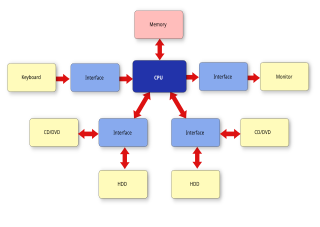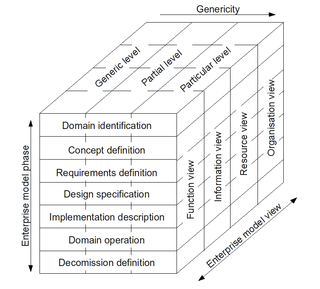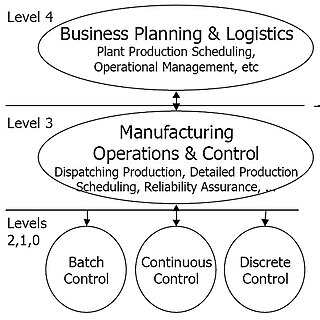Related Research Articles

IDEF, initially an abbreviation of ICAM Definition and renamed in 1999 as Integration Definition, is a family of modeling languages in the field of systems and software engineering. They cover a wide range of uses from functional modeling to data, simulation, object-oriented analysis and design, and knowledge acquisition. These definition languages were developed under funding from U.S. Air Force and, although still most commonly used by them and other military and United States Department of Defense (DoD) agencies, are in the public domain.

CIMOSA, standing for "Computer Integrated Manufacturing Open System Architecture", is an enterprise modeling framework, which aims to support the enterprise integration of machines, computers and people. The framework is based on the system life cycle concept, and offers a modelling language, methodology and supporting technology to support these goals.
A functional software architecture (FSA) is an architectural model that identifies enterprise functions, interactions and corresponding IT needs. These functions can be used as a reference by different domain experts to develop IT-systems as part of a co-operative information-driven enterprise. In this way, both software engineers and enterprise architects can create an information-driven, integrated organizational environment.

A metamodel is a model of a model, and metamodeling is the process of generating such metamodels. Thus metamodeling or meta-modeling is the analysis, construction, and development of the frames, rules, constraints, models, and theories applicable and useful for modeling a predefined class of problems. As its name implies, this concept applies the notions of meta- and modeling in software engineering and systems engineering. Metamodels are of many types and have diverse applications.

Enterprise integration is a technical field of enterprise architecture, which is focused on the study of topics such as system interconnection, electronic data interchange, product data exchange and distributed computing environments.

A system architecture is the conceptual model that defines the structure, behavior, and views of a system. An architecture description is a formal description and representation of a system, organized in a way that supports reasoning about the structures and behaviors of the system.
Data integration refers to the process of combining, sharing, or synchronizing data from multiple sources to provide users with a unified view. There are a wide range of possible applications for data integration, from commercial to scientific.
Several methods have been created to define an assessment process for free/open-source software. Some focus on some aspects like the maturity, the durability and the strategy of the organisation around the open-source project itself. Other methodologies add functional aspects to the assessment process.

Enterprise modelling is the abstract representation, description and definition of the structure, processes, information and resources of an identifiable business, government body, or other large organization.
Enterprise engineering is the body of knowledge, principles, and practices used to design all or part of an enterprise. An enterprise is a complex socio-technical system that comprises people, information, and technology that interact with each other and their environment in support of a common mission. One definition is: "an enterprise life-cycle oriented discipline for the identification, design, and implementation of enterprises and their continuous evolution", supported by enterprise modelling. The discipline examines each aspect of the enterprise, including business processes, information flows, material flows, and organizational structure. Enterprise engineering may focus on the design of the enterprise as a whole, or on the design and integration of certain business components.

Generalised Enterprise Reference Architecture and Methodology (GERAM) is a generalised enterprise architecture framework for enterprise integration and business process engineering. It identifies the set of components recommended for use in enterprise engineering.
François B. Vernadat is a French and Canadian computer scientist, who has contributed to Enterprise Modelling, Enterprise Integration and Networking over the last 40 years specialising in Enterprise Architectures, business process modelling, information systems design and analysis, systems integration and interoperability and systems analysis using Petri nets.
Peter Bernus is a Hungarian Australian scientist and Associate Professor of Enterprise Architecture at the School of Information and Communication Technology, Griffith University, Brisbane, Australia.

ISO 19439:2006 Enterprise integration—Framework for enterprise modelling, is an international standard for enterprise modelling and enterprise integration developed by the International Organization for Standardization, based on CIMOSA and GERAM.
Model Driven Interoperability (MDI) is a methodological framework, which provides a conceptual and technical support to make interoperable enterprises using ontologies and semantic annotations, following model driven development (MDD) principles.

Purdue Enterprise Reference Architecture (PERA), or the Purdue model, is a 1990s reference model for enterprise architecture, developed by Theodore J. Williams and members of the Industry-Purdue University Consortium for Computer Integrated Manufacturing.
Guy Doumeingts is a French engineer, Emeritus professor at the University of Bordeaux 1 and former Director of "Laboratoire d’Automatique, Productique Signal et Image" control theory, known for the development of the GRAI method and his contributions to the field of Enterprise modelling.
Bruno Vallespir is a French engineer, and Professor of Enterprise Modelling at the University of Bordeaux, working in the fields of production management, performance evaluation and enterprise modeling.
The history of business architecture has its origins in the 1980s. In the next decades business architecture has developed into a discipline of "cross-organizational design of the business as a whole" closely related to enterprise architecture. The concept of business architecture has been proposed as a blueprint of the enterprise, as a business strategy, and also as the representation of a business design.
Gregory Zacharewicz is Full Professor at École des mines d'Alès in Alès, France. He recently joined the LGI2P laboratory in 2018 to develop research based on simulation. He was previously Associate Professor at the University of Bordeaux (2007-2018), where he conducted research on modeling, interoperability and simulation of business and social organization. He worked with Bruno Vallespir and Guy Doumeingts and under the direction of Claudia Frydman and Norbert Giambiasi.
References
- ↑ McCarthy, Ian, and Michalis Menicou. "A classification schema of manufacturing decisions for the GRAI enterprise modelling technique." Computers in Industry 47.3 (2002): 339-355.
- ↑ Doumeingts, G. (1984) La Méthode GRAI. PhD. Thesis, University of Bordeaux I, Bordeaux, France. (In French).
- ↑ Chen, David, Bruno Vallespir, and Guy Doumeingts. "GRAI integrated methodology and its mapping onto generic enterprise reference architecture and methodology." Computers in industry 33.2 (1997): 387-394.
- ↑ Doumeingts, G., Vallespir, B., Zanettin, M. and Chen, D. (1992) GIM, GRAI Integrated Methodology - A methodology for Designing CIM systems, Version 1.0. Unnumbered Report, LAP/GRAI, University of Bordeaux I, France
- ↑ Aguilar-Saven, Ruth Sara. "Business process modelling: Review and framework." International Journal of production economics 90.2 (2004): 129-149.